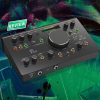
Review: Two Notes ReVolt Guitar
A tone beast with multiple use case scenarios. Your amp never felt so insecure.
You know when your guitar tone feels a little… dry? I occasionally hit this ‘tone rut’ regardless of whether I’m using a fully analogue or fully digital signal chain. I find myself wallowing in a creative wilderness of sounds, effects and textures that have become overly familiar and uninspiring. The only way out, of course, is to acquire a new piece of gear.
Okay, not always. But new gear can help. Especially if you’re an amps and pedals person. There’s nothing like sending the waves of electrons charging down your guitar cable through undiscovered mazes of copper, tubes and transistors to enhance your tone and kickstart fresh inspiration.
Well, that’s how it felt the first time I plugged my guitar into the Two Notes ReVolt Guitar. Fresh, responsive, vigorous; a delightful antidote to tone rut.
ALL ANALOGUE
The ReVolt Guitar is a peculiar product with a purpose that isn’t entirely self evident at first glance. Firstly, it can be used completely standalone. Flick on the cabinet simulation (based on a Marshall 4×12) and plug the balanced XLR output into a set of speakers, the front-of-house system, or an audio interface, and you’re all set. In this configuration, the ReVolt’s FX send and return lets you add your effects pedals into the chain if you desire.
But there are two other ways to use ReVolt that let you incorporate your guitar amp. Full integration is achieved via the ‘four cable method’: guitar into ReVolt > ReVolt FX Send into amp input > amp FX send into ReVolt FX Return > ReVolt output into amp FX return. This essentially adds three extra channels to your amplifier, and it’s a wonderful way to breathe new life into an amp that’s become boring or has limited sonic scope.
The final ‘hybrid’ method feeds ReVolt’s preamp circuit into the power amplification stage of your existing amp. To do this, take the ReVolt’s FX Send into your amp’s FX return and make sure the Cab Sim and 4-Cable Method switches are off.
REVOLT DNA
Now that the ReVolt’s use cases are established, what exactly is it?
At heart, it’s a fully analogue three-channel preamplifier running on 200V with a 12AX7 tube stage for authentic amp vibes. Each channel is modelled after a classic – a Fender Bassman clean, a Marshall JMP Superlead overdrive, and a Soldano SLO100 lead – and tapping the channel’s footswitch a second time engages a boost for an extra hit of gain (which makes the tube light up red). Basic tone-shaping controls are available. Aside from individual Volume and Gain knobs per channel, the Clean channel has controls for Treble and Bass, and the Crunch and Lead channels share a three-band Bass/Mid/Treble EQ. The white Boost knob sticks out like a sore thumb against the otherwise exclusively black knobs and determines how hard the Boost drives the channels when applied. Bypass the unit by tapping the Clean and Crunch footswitches at the same time.
At this point it may sound like ReVolt is basically a guitar amp head in the shape of a pedal. There’s even a separate Output on a TS connector designed to send signal to a cabinet (via a power amp) or IR host (like Two Notes’ own Torpedo C.A.B. M+). But the onboard Cabinet Simulation really gives ReVolt wings, sonically and practically. That’s partly because, from a functionality perspective, ReVolt is all you need to produce a full guitar tone. But also, for the type of product it is, ReVolt does a fantastic job of simulating a real cabinet.
NEED TO KNOW
Two Notes ReVolt Guitar
3-Channel Analogue Guitar Preamp

THE FEELS
I was anything but revolted the first time I plugged into the ReVolt Guitar. Quite the opposite, in fact; I was amazed how darn close it felt to playing through a quality amp via the balanced output with Cab Sim activated. Big clean chords presented richly with soul-warming lusciousness, purity and tight lows, while a harder pluck or strum revealed a snappy edge with biting transients.
Then there’s the Crunch channel – a gorgeous harmonic mess, dripping with complexity and clarity in equal measure. The gain knob here is wide enough to cover all flavours from a gently broken up Stevie Ray Vaughn tone to a Hendrix-esque wall of grit. A gentle roll back of the volume pot on my PRS hollowbody neatly cleaned up the overdrive while preserving the tone’s integrity. The Lead channel builds nicely on the Crunch with the Bass, Mid and Treble knobs letting you dial in a creamy or fizzy tone based on your taste. Sustain lasts for days on this channel, and even more so when you switch on the Boost.
All this is with the cabinet simulation plugged straight into my audio interface and through my studio monitors. At the time of writing this paragraph, I still haven’t tested the ReVolt with my amplifier – and, to be honest, I’m in no hurry. After adding a GFI Systems Specular Tempus effects pedal to the ReVolt’s FX loop, I am utterly content to forego any extra hardware. Three variants of top-shelf electric guitar tone (six if you count the Boost) feeding cleanly into my interface via a balanced XLR output (no extra DI box, don’t you love that?) with tasty reverb and delay on tap. What’s not to love? There’s even a 3.5mm headphone output and aux input for silent jams. Within minutes I caught myself daydreaming about how stage-friendly this rig is. Not long after I was dangerously close to admitting that when two pedals can sound this good, lugging a big amp and cab into a venue is simply not worth the trouble. Plus, the FOH engineer would love me forever. Hmm, I wonder how much my amp would sell for on Marketplace…
fresh, responsive, vigorous; a delightful antidote to tone rut

AMPED UP
Perhaps you’re a little more attached to your beloved amp and cab (or amps and cabs). ReVolt still very much has a place in your life. Those three channels can become a solid foundation of tonal options either to augment or revamp an amp’s potential. And you can build tonal complexity on this foundation by virtue of pedalboard goodies.
Since ReVolt’s unbalanced TS output is void of any cab simulation, this makes the perfect scenario to take this into a virtual cab impulse response, or a physical cabinet through a power amp. I already mentioned Two Notes’ C.A.B. M+. The company also has a plug-in called Wall Of Sound, featuring over 600 virtual cabs with eight mic options for each. Each cab is enormously tweakable thanks to the innovative DynIR format which combines the realness of impulse responses with the flexibility of dynamic adjustment.
Included with a purchase of ReVolt Guitar is the Series-G DynIR Cabinet Collection with 10 impulse response captures of famous cabinets which can be used with C.A.B. M+. You also get a lifetime license to the Wall Of Sound cab simulator plug-in.
What I haven’t talked about yet is the ReVolt’s MIDI functionality. Two 3.5mm MIDI connectors on the rear allow integration into larger setups. Two Notes gives you extensive control over the MIDI behaviour, such as per-channel control of the default FX loop state, channel change messages, bypass states, and MIDI Learn. Accessing these controls is through the typically cryptic method of footswitch presses and combinations – you’ll need the User Manual for this!
ALL BASES COVERED
It’s hard not to fall in love with the Two Notes ReVolt Guitar. Playing through the unit quickly brings a guitarist back in touch with what it’s all about: the pure joy of great tone, which spontaneously invites creative expression and experimentation.
Then there’s the flexibility, which to me, is as enticing as the tone itself. Enliven a tired old amplifier with the colours and flavours of ReVolt’s all-analogue circuitry – there’s nothing to lose, and lots to gain (pun intended). Take ReVolt to a gig with a handful of favourite stompboxes and leave the amp at home, safe in the knowledge that the tone out front will impress the punters. In the studio, plug straight into the console or audio interface for punch and presence without any physical miking. Or if you’re rehearsing at 11:30pm for tomorrow’s show, plug in your headphones and play your heart out – it’ll sound awesome, and the rest of the house can stay asleep.
Whatever your setup, ReVolt Guitar will slide effortlessly into it, and most likely make things better – even if you aren’t in a tone rut.



























RESPONSES